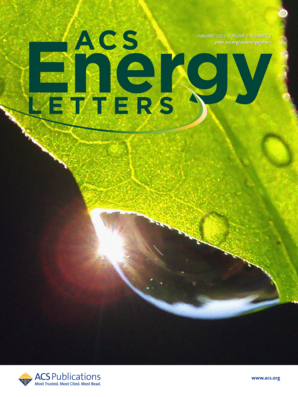Design of Ligand‐Nonbridging Sites in Metal‐Organic Frameworks for Boosting Lithium Storage Capacity
IF 19.3
1区 材料科学
Q1 CHEMISTRY, PHYSICAL
引用次数: 0
Abstract
Metal‐organic frameworks (MOFs) are lagging in the use of lithium‐ion batteries (LIBs), ascribing to full coordination between metal nodes and organic ligands, to a large extent. By integrating a modulator into a ligand with missing bridging functionality, this study elucidates the role of non‐bridging defect sites in MOFs in tailoring lithium storage performance. A fully bridged pristine MOF (p‐MOF) utilizing the meso‐tetra(4‐carboxylphenyl) porphyrin ligand is compared with a modified MOF containing non‐bridging defects (d‐MOF) introduced by a homologous ligand, tris(4‐carboxyphenyl) porphyrin. Spectroscopic and cryogenic low‐dose electron microscopy techniques verify the presence of non‐bridging defect sites in the d‐MOF and reveal their explicit local structure. Density functional theory calculations show significantly enhanced Li+ adsorption energies and reduced Li+ migration barriers at the non‐bridging sites in the d‐MOF compared to the fully bridging sites in the p‐MOF. As a result, the d‐MOF exhibits exceptional lithium storage performance, achieving a high capacity of 761 mAh g−1 at 0.05 A g−1 and superior rate performance of 203 mAh g−1 at 5 A g−1, which substantially outperform the p‐MOF. This study highlights the potential of modulating MOFs with non‐bridging defects to develop high‐performance LIBs.设计金属有机框架中的配体非杂化位点以提高锂存储容量
金属有机框架(MOFs)在锂离子电池(LIBs)中的应用滞后,这在很大程度上归因于金属节点与有机配体之间的完全配位。本研究通过将调制剂整合到桥接功能缺失的配体中,阐明了 MOF 中的非桥接缺陷位点在定制锂存储性能中的作用。研究比较了利用中-四(4-羧基苯基)卟啉配体的完全桥接原始 MOF(p-MOF)和由同源配体三(4-羧基苯基)卟啉引入的含有非桥接缺陷的修饰 MOF(d-MOF)。光谱和低温低剂量电子显微镜技术验证了 d-MOF 中非桥接缺陷位点的存在,并揭示了其清晰的局部结构。密度泛函理论计算显示,与 p-MOF 中的完全桥接位点相比,d-MOF 中的非桥接位点的 Li+ 吸附能显著增强,Li+ 迁移障碍显著降低。因此,d-MOF 表现出了卓越的锂存储性能,在 0.05 A g-1 的条件下实现了 761 mAh g-1 的高容量,在 5 A g-1 的条件下实现了 203 mAh g-1 的卓越速率性能,大大优于 p-MOF。这项研究凸显了利用非桥接缺陷调制 MOFs 开发高性能锂离子电池的潜力。
本文章由计算机程序翻译,如有差异,请以英文原文为准。
求助全文
约1分钟内获得全文
求助全文
来源期刊

ACS Energy Letters
Energy-Renewable Energy, Sustainability and the Environment
CiteScore
31.20
自引率
5.00%
发文量
469
审稿时长
1 months
期刊介绍:
ACS Energy Letters is a monthly journal that publishes papers reporting new scientific advances in energy research. The journal focuses on topics that are of interest to scientists working in the fundamental and applied sciences. Rapid publication is a central criterion for acceptance, and the journal is known for its quick publication times, with an average of 4-6 weeks from submission to web publication in As Soon As Publishable format.
ACS Energy Letters is ranked as the number one journal in the Web of Science Electrochemistry category. It also ranks within the top 10 journals for Physical Chemistry, Energy & Fuels, and Nanoscience & Nanotechnology.
The journal offers several types of articles, including Letters, Energy Express, Perspectives, Reviews, Editorials, Viewpoints and Energy Focus. Additionally, authors have the option to submit videos that summarize or support the information presented in a Perspective or Review article, which can be highlighted on the journal's website. ACS Energy Letters is abstracted and indexed in Chemical Abstracts Service/SciFinder, EBSCO-summon, PubMed, Web of Science, Scopus and Portico.
 求助内容:
求助内容: 应助结果提醒方式:
应助结果提醒方式:


